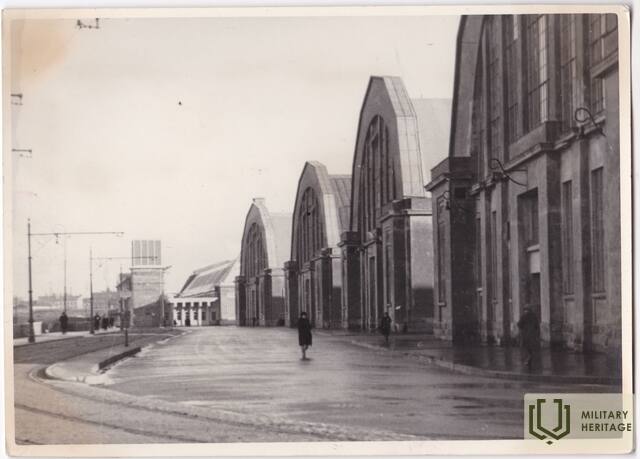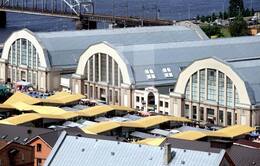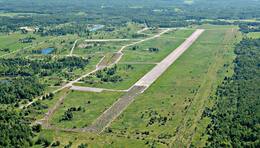Rygos centrinio turgaus angarai
Tuo metu, kai buvo statomas Rygos centrinis turgus, jis buvo vienas moderniausių pasaulyje. Jis buvo pastatytas naudojant Pirmojo pasaulinio karo vokiečių armijos dirižablių angarų metalines konstrukcijas. Autorius aprašo Rygos centrinio turgaus statybos prielaidas ir statybos darbų apimtį, todėl tai buvo vienas ambicingiausių statinių pokario Latvijoje ir vienas moderniausių turgų pasaulyje.
„Šių metų lapkričio 10 d. didžiausias Rygos atviras turgus prie Daugmalos upės nutraukė veiklą ir persikėlė į naujas, modernias, uždaras patalpas. Jį pakeitęs naujai pastatytas Centrinis turgus yra didžiausias pokario pastatas Latvijoje, todėl kitų savivaldybių darbuotojams taip pat bus įdomu jį pažinti. Kodėl Rygos miestas, esant dabartinėms sunkioms ekonominėms sąlygoms, griebėsi šio grandiozinio pastato pašalinimo? Visų pirma, dėl higieninių ir ekonominių priežasčių. Atviruose turguose, atviro turgaus trobelėse ar net ant atvirų stalų eksponuojamos prekės yra veikiamos tiesioginių saulės spindulių, atmosferos ir dulkių ir labai greitai genda. Jei galime tikėti užsienio tyrimų duomenimis apie prekių gedimą atviruose turguose, turime manyti, kad esant didelei Daugmalos turgaus apyvartai, kasmet prarandama maždaug 1–2 milijonų latų vertės prekių. Todėl suprantama, kaip rodo užsienio patirtis, kad pastatytos turgaus halės, kurios, tačiau jos labai brangios, o nuoma vis dar daug brangesnė nei atviruose turguose, niekur nesukėlė prekių kainų padidėjimo, o dažniausiai – nedidelio kainų kritimo. Žinoma, svarbu ir tai, kad statant naujus turgaus pastatus, jie dažniausiai statomi netoli stočių, o tai taip pat leidžia sumažinti prekių gabenimo išlaidas. Ryga jau prieš karą pradėjo statyti uždarus turgaus pastatus, pirmiausia pradėdama nuo mažesnių Matīsos (dabar Vidžemė) ir Āgenskalnos turgaviečių. Daugmalos turgaus perkėlimo klausimas taip pat buvo svarstomas apie 1909–1910 m. Po karo miestas pradėjo išsamiau svarstyti šį klausimą 1922 m., kai gavo Valstybės turto įsigijimo komisijos pasiūlymą įsigyti Vainodės cepelinų angarus, kuriuos kitaip buvo nuspręsta išardyti ir parduoti metalo laužui. Apžiūrėję šiuos angarus, miesto atstovai sugalvojo juos panaudoti turgaus pastatams. Iš pradžių buvo ketinama juos pervežti į Rygą ir čia įrengti originalia forma, o išsamiau išnagrinėjus šį klausimą, buvo nuspręsta statyti masyvius pastatus su visais šiuolaikiniais turgaus patogumais, naudojant iš Vainodės angarų gautas geležines konstrukcijas. Naujoji turgaus vieta „šalia raudonųjų sandėlių“ buvo pasirinkta pirmiausia dėl eismo sąlygų. Čia turgus galėjo būti aprūpintas tiesiogine geležinkelio atšaka iš Rygos pagrindinės stoties, be to, jis buvo pasiekiamas baržomis per Dauguvą ir miesto kanalą. Žinoma, svarbu buvo ir tai, kad miestui čia priklausė didesni, iki tol visiškai nereikšmingi, žemės plotai. Turgaus projektui buvo paskelbtas konkursas, kuriame aktyviai dalyvavo ne tik vietos gyventojai, bet ir visas būrys užsienio specialistų. Tačiau nė vienas iš laimėjusių projektų nebuvo įgyvendintas, tačiau, atsižvelgdamas į šiuose projektuose išreikštas idėjas, miestas, dalyvaujant keliems vietos specialistams, parengė savo projektą. Statybos darbai prasidėjo 1924 m. birželį, ir iš pradžių buvo ketinama statybas atlikti per penkerius metus, kasmet iš miesto biudžeto statybos reikmėms imant po milijoną latų. Statybų metu pačioje turgaus struktūroje buvo atlikta dar keletas pakeitimų, dėl kurių reikėjo skirti papildomų lėšų (turgus kainavo šiek tiek daugiau nei 6 milijonus latų), o anksčiau numatytos sumos jokiais metais negalėjo būti įtrauktos į biudžetą.
„(..) Visi 5 pastatai pastatyti ant betoninių pamatų; rūsiuose yra gelžbetoninės grindys; pastatų sienos – plytos. Stogas remiasi į geležines konstrukcines arkas, todėl sienos nelaiko jokio svorio. Daugelio komercinių pastatų stogo danga yra skalūnas, likusių – stogo veltinis. Pastatai yra šildomi, todėl tiek sienose, tiek stoguose yra dvigubo stiklo langai, o daugumos komercinių pastatų stogai šildomi dvigubo stiklo apkala ir izoliacija. Šaldymo patalpoms apšiltinti taip pat naudojamos kamštinės lentos. Visuose pastatuose yra bendra žemo slėgio garo šildymo sistema su garų perkaitinimu iki maždaug 250 °C. Atskirų pastatų šildymas atliekamas radiatoriais ir radiatoriais, įrengtais durų angose. Radiatoriai su juose įmontuotais ventiliatoriais leidžia orui įsiurbti į patalpas, jį sušildyti ir nukreipti į grindis, per kuriuos pasiekiama vienoda patalpos temperatūra. Visuose pastatuose, įskaitant rūsius, įrengta trijų krypčių ventiliacija: 1. Vėdinimas grynu oru, įsiurbiant jį iš pastato išorės per radiatorių ir pučiant į patalpą sušildytą. 2. Oro ištraukimas...“ pasenęs oras su ventiliatoriais. 3. Natūralios ventiliacijos žaliuzės. Visuose pastatuose įrengtas elektrinis apšvietimas. Statybai buvo sunaudota 6 000 000 plytų; 60 000 barelių cemento; 2460 tonų geležies. (..)“
Laikraštis „Savivaldybės balsas“, naujasis Rygos centrinis turgus. Nr. 10. 1930 m.
Susijusi laiko juosta
Susijusios temos
Susijusios vietos
Rygos centrinio turgaus cepelinų angarai
Įsikūręs Rygos centre, priešais Rygos tarptautinę autobusų stotį, netoli Rygos geležinkelio keleivių stoties.
Rygos centrinis turgus yra didžiausias turgus Latvijoje, kadaise laikytas geriausiu ir moderniausiu turgumi Europoje. Ryškiausias jo simbolis – 1920-aisiais pastatyti turgaus paviljonai, kurie iš pradžių buvo naudojami kariniams tikslams.
Pirmojo pasaulinio karo metu Vokietijos armija Kuržemėje įkūrė Vainodės oro uostą, kuriame nuolat buvo dislokuoti keli dirižabliai. Tai buvo pailgi balionai, pripildyti dujų, su prie korpusų pritvirtintomis patalpomis keleiviams ir kroviniams gabenti. Valdymą užtikrino vidaus degimo arba elektrinis variklis ir sparnas korpuse. Dirižabliai buvo skirti žvalgybai arba priešo bombardavimui, pavyzdžiui, jie vykdė ataką prieš Rusijos armijos hidroplanų aerodromą netoli Ronių salos. Yra žinoma, kad angarai buvo vadinami „Walhalla“ ir „Walther“.
Po Latvijos nepriklausomybės karo angarai buvo išardyti ir panaudoti Rygos centrinio turgaus angarų statybai, ketinant palikti juos originaliuose matmenyse. Vėliau buvo nuspręsta naudoti tik viršutines angarų dalis.
Šiandien galite apžiūrėti Vokietijos armijos dirižablių angaro metalines konstrukcijas. Turgus leidžia maloniai susipažinti su pasaulinės aviacijos pradžios įrodymais. Ekskursijų užsakymas: +37167358157; gints.aksiks@rct.lv.
Vainodės oro bazė
Vainodės aerodrome vis dar yra 16 sovietmečio orlaivių angarų ir 1800 m ilgio kadaise 2500 m ilgio tako atkarpa. Aerodromą galima aplankyti tik iš anksto užsiregistravus. Vainodės aerodromas buvo įkurtas Latvijos nepriklausomybės metais kaip vienas iš Latvijos aviacijos lopšių, o vėliau tapo vienu didžiausių karinių aerodromų Baltijos šalyse. 1916 m. buvo pastatyti du angarai Vokietijos armijos dirižabliams. Dirižabliai buvo naudojami žvalgybai rinkti ir Rusijos armijos pozicijoms bombarduoti. Vėliau Rygos miestas įsigijo dirižablių angarus ir panaudojo jų stogo konstrukcijas Rygos centrinio turgaus paviljonams pastatyti. 1940 m. gegužę į Vainodę persikėlė 31-asis Raudonosios armijos greitųjų bombonešių aviacijos pulkas ir pradėta standartizuoto betoninių plokščių tako statyba. 1944 m. vasaros pabaigoje nebaigtu aerodromu naudojosi įvairūs vokiečių aviacijos daliniai, tačiau Antrojo pasaulinio karo pabaigoje tą patį aerodromą naudojo Raudonosios armijos aviacijos daliniai, kovoję su vokiečių armijos grupuote „Kurzeme“. Po Antrojo pasaulinio karo Sovietų Sąjungos oro pajėgos Vainiodėje buvo dislokuotos iki 1992 m.








